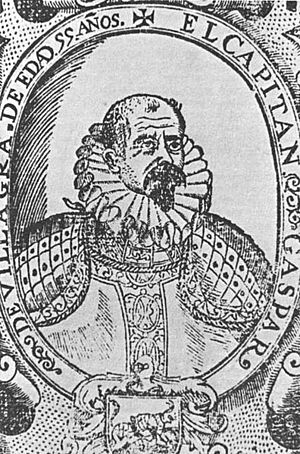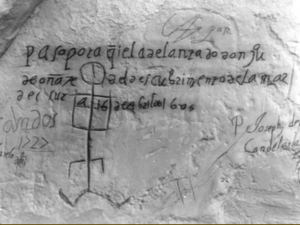Gaspar Pérez de Villagrá facts for kids
Gaspar Pérez de Villagrá (born 1555 – died 1620) was an important Spanish captain and legal officer. He was part of the Juan de Oñate expedition that first explored and settled Santa Fe de Nuevo México in 1598. He is most famous for writing a long poem called Historia de la Nueva México, which was published in 1610. This poem tells the story of the early Spanish settlement in what is now the American Southwest.
He was born in Puebla de Los Angeles, a city in New Spain (which is now Mexico). His father was Spanish, and Gaspar was one of the few people born in the New World who got to study in Europe. He earned a degree from the University of Salamanca in Spain in the 1570s, where he studied ancient Greek and Roman writers. After his studies, he returned to New Spain.
Contents
Early Life and Education
Gaspar Pérez de Villagrá was born in 1555 in Puebla de Los Ángeles, near Mexico City. He is known as one of the first people to write about the Spanish conquest of the Americas. He is also seen as an early writer in Latino literature in the United States. His father, Hernan Pérez de Villagrá, came from Spain. Even though Gaspar was born in the New World, he felt just as Spanish as those born in Spain.
Not much is known about his childhood. However, he was lucky enough to be one of the few people born in the Americas who got to study in Spain. He earned his degree from the famous University of Salamanca. It is not clear when he came back to New Spain, but it was before he joined Don Juan de Oñate's group in 1596. He was made a captain and legal officer for Oñate's journey into New Mexico.
The Oñate Expedition
In 1579, a Native American captive in Santa Bárbara spoke of large cities beyond the Chihuahua desert. This news reached a Franciscan friar named Agustín Rodríguez, who told the viceroy (a high-ranking Spanish official). This led to several trips to explore the area. Finally, in 1595, Oñate asked for permission to conquer and rule New Mexico. His request was approved in 1598.
Oñate's expedition in 1598 was very well-prepared. His goal was not just to find riches but also to start a colony with many settlers. Villagrá joined this expedition in 1596. He saw and took part in the events that led to the Spanish control and settlement of the Pueblo Native Americans in New Mexico.
The expedition, with about 400 people, started its journey from Zacatecas in northern Mexico. After some delays, they finally left on January 26, 1598. They traveled through mountains, deserts, and strong rivers. After many dangerous adventures, they crossed the fast-flowing Rio Grande River in July 1598, near what is now El Paso, Texas. To show their thanks, Oñate ordered a special Mass. Afterward, everyone watched a play written by one of the soldiers. This was the first European play performed in the United States. These plays helped show the power of the Spanish Empire to the amazed Native people.
The expedition set up its main camp in San Juan. From there, Oñate sent Gaspar Pérez de Villagrá and other captains to explore for towns, riches, and resources. The first Spanish settlers in New Mexico moved from San Juan in 1598. They then moved to San Gabriel in 1601, and later to Santa Fe in 1607. The explorers did not find much, and some settlers became unhappy and wanted to leave. Oñate punished some of the settlers who led this unhappiness.
It is said that Villagrá, who was strong and brave, was once left alone with his dog and horse after a chase. He traveled through the desert looking for Oñate. After several days, he was so hungry and thirsty that he had to kill his loyal dog and drink its blood to survive. He was almost dead when soldiers found him. Later, he showed great bravery at Acoma, a strong village of warlike Native Americans. He made a daring leap across a deep gap where his friends had placed a log as a bridge.
Oñate was also known for treating the Native Americans harshly. The Pueblo people, who were controlled, mistreated, and had their food and lands taken, soon began to fight back. In 1599, the important battle of Acoma happened. Many Native Americans were defeated and forced from their homes. This marked the Spanish victory over the Pueblo. Pérez de Villagrá's book, Historia de la Nueva México, is a great work of literature. In it, he is also one of the main characters who helped organize the new territory. Most importantly, his book tells the story of this key moment in American history.
In 1600, Oñate sent Villagrá back to Mexico with an escort to get more supplies and men. When the group was ready to return to New Mexico, the viceroy removed Villagrá from his command. Angry, Villagrá sought safety in a church to avoid returning in a lower position. In 1605, he left for Spain, hoping the king would reward him for his service in New Mexico. Five years later, his long poem Historia de la Nueva Mexico was published as a book in Alcalá de Henares, Spain. It covered the first year of Oñate's settlement.
Later Life and Career
After the expedition ended, some colonists went to Spain. They accused Oñate of being a harsh ruler, and he was removed from his position in 1607. After the expedition, Villagrá is thought to have worked as a major from 1601 to 1603 in Guanacevi, before going back to Spain in 1605. While in Spain, he likely followed the royal court and later settled in Alcalá de Henares, where his book Historia de la Nueva México was published in 1610.
Pérez de Villagrá hoped his epic poem would convince King Phillip III to give him an important job in the New World. However, the king did not grant his wishes. In 1614, Pérez de Villagrá was found guilty, while not present, of causing the deaths of two people who had left the Juan de Oñate expedition. He was banned for six years from New Mexico and two years from the viceroy's court in New Spain.
Finally, Pérez de Villagrá's requests were heard. In 1620, he was appointed mayor of Zapotitlan in Guatemala. But on his way to this new job, Villagrá died on a ship heading back to the Americas and was buried at sea.
Historia de la Nueva Mexico
In 1610, Villagrá published his first book, Historia de la Nueva México. It is a long poem that describes the events of the Oñate Expedition in New Mexico. It starts with their journey from Mexico City in 1596 and ends with the Spanish attack on the Acoma Pueblo in 1599. The poem was written for King Philip III of Spain. It tries to show all the good things the Spanish did during the expedition. Because of this, it can be hard to call the poem a completely fair historical document.
Many people believe this poem is America's first epic poem. It is also one of the earliest pieces of writing from the colonial period. It even came before John Smith's General History of Virginia from 1624.
The book is written in a special style. It has 11,891 lines that do not rhyme, divided into 34 parts called cantos. Villagrá used a classical style, like the ancient Roman poet Virgil's Aeneid. He also used ideas from other poems about the New World. An example from the poem, translated into English, is:
I sing of arms and the heroic man
Of those brave Spaniards '
The being, courage, care, and high emprise
Of him whose unconquered patience
Though cast upon a sea of cares,
In spite of envy slanderous,
In raising to new heights the feats, the deeds
The first edition of the poem was a small book. It was not very well-known, and only a few copies of the original exist today. In 1900, a copy was reprinted by the Museo Nacional de México. However, because it was in Spanish, not many scholars paid attention to it. In 1933, Gilberto Espinosa created an English translation. Since then, the poem has become more admired for Villagrá's efforts, writing style, and historical information. Historia de la Nueva México is now considered a valuable part of colonial literature.
About His Book
There are two main ways people have criticized Historia de la Nueva México. One criticism is that Villagrá tried to mix history with poetry. This limited him as an artist because he had to stick to the historical facts in order. He wanted his work to be a masterpiece like those of Homer and Virgil, but the need to be factual kept him from being more creative. As historian Miguel Encinias said, "Villagrá's poem contains practically nothing that may be considered novelistic or fantastic."
Another criticism is that Villagrá used too many classical and literary elements, which made the poem feel heavy and repetitive. Encinias noted that "the poem is overly filled, with poetic comparisons." Villagrá tried to connect the people of the Oñate expedition to characters from Greek and Roman myths. This became a bit silly because he made so many of these connections.
Some critics have said that Historia was an early example of what would later become historical novels in the 1800s in Europe. Even though Pérez de Villagrá was in Spain at the same time Cervantes published Don Quixote, it is not known if they knew each other's works.
In recent years, especially since a new edition of Historia de la Nueva México was published in 1992, people have tried to see Pérez de Villagrá as a key figure in Latino literature. While he might not always be accurate with dates and events, and his descriptions of Native Americans have been criticized as being too protective, his work still introduces ideas that would become important in Latino writing for future generations.
Images for kids
See also
 In Spanish: Gaspar Pérez de Villagrá para niños
In Spanish: Gaspar Pérez de Villagrá para niños








